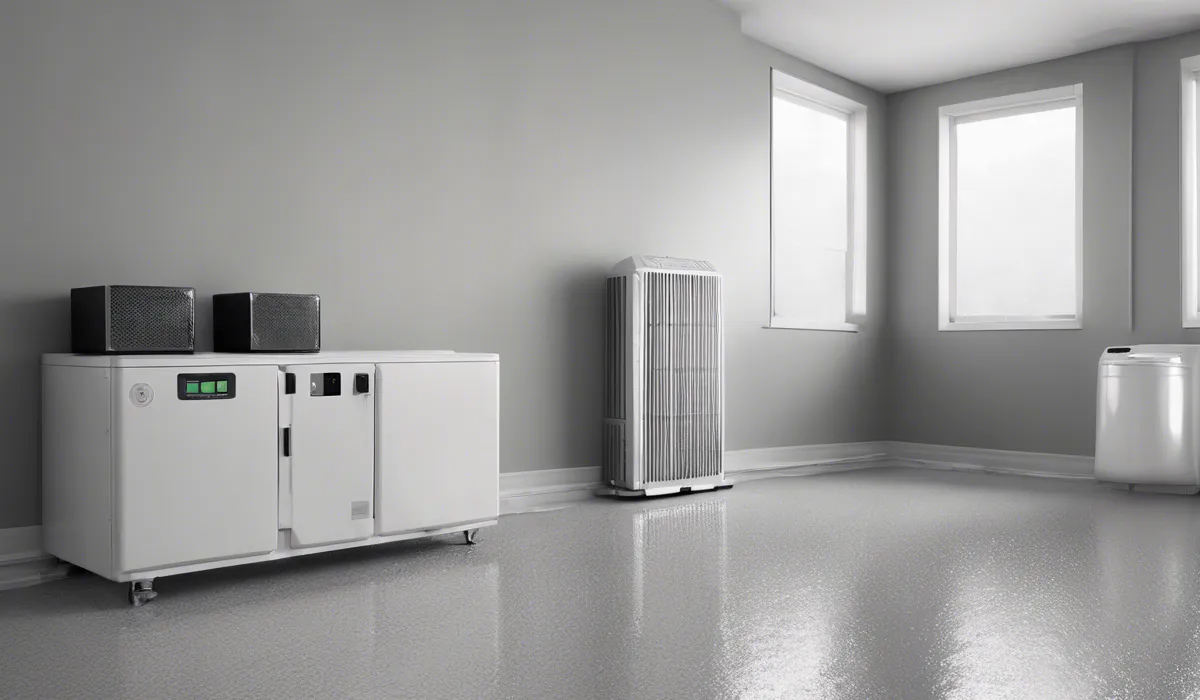A dehumidifier cannot kill mold, but it can prevent its growth by reducing indoor humidity levels. Mold thrives in moist environments, so maintaining humidity below 50% can hinder its proliferation. For existing mold, additional cleaning and removal steps are necessary.
Understanding Mold and Humidity

What is Mold?
Mold is a type of fungus that can grow indoors and outdoors. It comes in various colors and forms, and it spreads by releasing tiny spores into the air.
These spores are invisible to the naked eye and can start new mold growths when they land on surfaces that have the right conditions for mold to thrive.
Growth Requirements for Mold
To grow, mold needs moisture, a food source, and the right temperature. Materials like paper, wood, and drywall can provide food for mold. Temperatures that are comfortable for humans are often ideal for mold growth as well.
The Role of Humidity in Mold Growth
Humidity, or the amount of moisture in the air, plays a significant role in mold growth. High humidity creates damp conditions that mold loves.
When indoor humidity levels are high, it’s easier for mold to grow on walls, ceilings, and other surfaces.
Keeping Humidity in Check to Prevent Mold
To prevent mold, it’s crucial to keep indoor humidity levels low. Experts recommend maintaining indoor humidity between 30% and 50%.
This range is low enough to discourage mold growth, but comfortable for people to live in.
The Functionality of Dehumidifiers

How Dehumidifiers Work?
Dehumidifiers remove moisture from the air, helping to maintain the recommended humidity levels.
They work by drawing in air and passing it over cold coils. As the air cools, moisture condenses on the coils and drips into a collection tank or drains away.
Types of Dehumidifiers
There are several types of dehumidifiers, including refrigerant-based, desiccant, and whole-house systems.
Refrigerant-based dehumidifiers are common for residential use, while desiccant models are often used in climates with lower temperatures. Whole-house systems are integrated into a home’s HVAC system to control humidity throughout the entire house.
Effectiveness of Different Dehumidifiers
The effectiveness of a dehumidifier depends on the type, size, and conditions it’s used in. Larger spaces may require a dehumidifier with a higher capacity. The specific humidity level you’re trying to achieve will also impact which dehumidifier is best for your needs.
Limitations in Combating Mold
While dehumidifiers can prevent mold by lowering humidity, they can’t kill existing mold. Once mold is present, other methods, such as cleaning with mold-killing solutions, are necessary to remove it.
Best Practices for Mold Prevention and Dehumidifier Use

Maintaining Optimal Humidity with a Dehumidifier
To keep humidity levels in the ideal range, use a dehumidifier with a built-in hygrometer. This tool measures the humidity in the air, allowing the dehumidifier to turn on or off as needed to maintain the desired level.
Combining Dehumidification with Other Preventive Measures
Alongside using a dehumidifier, it’s important to address other factors that contribute to mold growth. Fix leaks promptly, ensure good ventilation, especially in areas like bathrooms and kitchens, and use mold-resistant building materials when possible.
Cleaning Tips for Existing Mold
If you have existing mold, clean it with a solution designed to kill mold, such as one that contains bleach or vinegar. Always wear protective gear and follow safety instructions when handling mold-killing products.
Proper Dehumidifier Care and Placement
To ensure your dehumidifier works effectively, place it in an area with good air circulation. Keep it away from walls and furniture, and make sure to empty the water collection tank regularly.
Clean the air filter as recommended by the manufacturer to maintain optimal performance.
FAQs About Can a Dehumidifier Kill Mold
Can a dehumidifier kill existing mold?
No, a dehumidifier cannot kill existing mold, but it can prevent further growth by reducing humidity.
What humidity level should I maintain to prevent mold growth?
To prevent mold growth, it is recommended to keep indoor humidity levels below 50%.
What should I do to remove mold that is already present?
For existing mold, you should clean and remove it using appropriate mold removal products and methods.
Does reducing humidity with a dehumidifier improve air quality?
Yes, reducing humidity with a dehumidifier can improve air quality by hindering mold growth and reducing allergens.
Is a dehumidifier enough to combat a severe mold problem?
No, while a dehumidifier can help prevent mold growth, severe mold problems may require professional mold remediation.
Final Thoughts
A dehumidifier is effective in preventing mold by keeping indoor humidity levels under 50%, creating an unfavorable environment for its growth.
However, it cannot kill existing mold. Eradicating established mold requires specific cleaning and removal interventions beyond humidity control.
